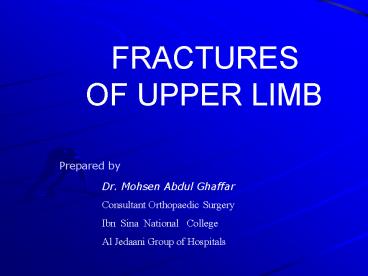Prepared by - PowerPoint PPT Presentation
1 / 32
Title:
Prepared by
Description:
Prepared by. FRACTURES. OF UPPER LIMB . Dr. Mohsen Abdul Ghaffar . Consultant OrthopaedicSurgery. Ibn Sina National College . Al Jedaani Group of Hospitals – PowerPoint PPT presentation
Number of Views:21
Avg rating:3.0/5.0
Title: Prepared by
1
FRACTURES OF UPPER LIMB
- Prepared by
Dr. Mohsen Abdul Ghaffar Consultant
Orthopaedic Surgery Ibn Sina National College
Al Jedaani Group of Hospitals
2
Acute Anterior DislocationOf The Shoulder
- Most common shoulder dislocation , about 98
- - Mechanism of Injury - Falling on outstretched
hand, the - limb behind the body. Trauma to UL while in
extension, - abduction ,ext.rotation
- - Clinically severe pain ,loss of contour, loss
of range of - movement, head of the humerus is palpable
in sub- - subcoracoid space , sometimes in
subclavicular area - - X-Ray AP lat. especially Axillary view
- - Treatment - Closed reduction under anaethesia
is recommended .Open reduction is indicated in
open injury, irreducible cases , associated
fracture . - - Complications Circumflex nerve injury ,
vascular injury - ( Axillary artery), Rotator cuff tear,
Fracture dislocation , - Stiffness ,Recurrent dislocation, locking .
3
(No Transcript)
4
Acute Posterior DislocationOf The Shoulder
- Less common , often misdiagnosed
- - Mechanism of Injury Internal
rotation,adduction,flexion - commonly follows electric shock injury or
convulsions - - Clinically Severe pain ,loss of contour ,
loss of range , - joint is locked in internal
rotation , the head - of the humerus is felt in
infraspinous area . - - X-Ray Axillary view is most important, if not
sure C.T. - - Treatment
- Closed reduction under GA, by traction
,external rotation - and pushing the head anteriorly .
- Surgery is indicated in irreducible
cases,locked posterior - dislocation ,
- - Complications Locking , fracture dislocation
, stiffness , - recurrent dislocation
- -
5
Fracture Clavicle
- - Insidence Frequent
- Patient any age
- Mechanism of injury
- - Fall on the shoulder .
- - Direct trauma .
- - Types Middle 1/3(85) , Lat.1/3(10) ,
Med.1/3(5) - - Management ,
- - Closed reduction immobilization with
clavicular strap, - 8- bandage or sling .
- - Open reduction internal fixation
rarely indicated for - marked displacement ,severely
comminuted ,extensive - soft tissue injury .
6
(No Transcript)
7
Fracture Of Proximal Humerus
- Incidence About 4-5 of all fractures
- Patient Any age, common in elderly, due to
osteoporosis - Mechanism of Injury - Fall on outstretshed hand
- - Direct
trauma to the side of the - shoulder
- Pathological Anatomy - Abduction type
- - Adduction
type - Treatment - Conservative treatment ,(
Immobilization - by sling arm-chest
bandage) , in non or - mild displacement
especially in elderly - - ORIF in displaced
irreducible conditions - especially in young
athlete - Complication Avascular necrosis ,non-union
,stiffness , - Circumflex nerve injury
,Vascular injury .
8
(No Transcript)
9
(No Transcript)
10
(No Transcript)
11
Examples of Internal FixationFracture surgical
Neck Rt. Humerusfixed by K-WiresA) Preop.
B) Postop.
12
Fracture Shaft Of Humerus
- Incidence Approximately 1 of all fractures
- Patient Any age
- Mechanism of Injury -Direct trauma
- -Indirect
trauma (Falling on hand, - RTA,
Twisting , Child abuse) - Comlications - Radial nerve injury
- - Delayed union
non-union - Treatment - Closed reduction
immobilization with a - splint or hanging cast .
- - Open reduction internal
fixation by plate - and screws or inter
locking nail .
13
Examples of Internal FixationComminuted
Fracture Rt. Humerusfixed by plate screws
14
Fractures Of Distal HumerusSupracondylar Fracture
- Incidence The most common fracture in children
- Patient Children less than 10 years, (peak from
5-8) - Mechanism of injury 2 types
- - Falling on outstretched hand
,Extension Type - - Falling on flexed elbow , Flexion Type
- Pathological Anatomy
- - Extension Type most common, the
distal fragment - is displaced
posteriorly - - Flexion Type fragment displaced
anteriorly, in both - types some
rotation is present - Treatment - Immobilization by POP
- - Closed reduction ,
percutaneous pinning - - Open reduction ,
internal fixation - Complications Nerve injury ( Median n.,Radial
n.),Vascular - injury (Brachial
artery), Deformity (Cubitus varus - is more common
,Cubitus valgus is rare),Stiffness
15
(No Transcript)
16
(No Transcript)
17
Example of Internal FixationSupracondylar
Fracture Lt. Elbowfixed by K-Wires
18
(No Transcript)
19
(No Transcript)
20
(No Transcript)
21
Dislocation Elbow
22
(No Transcript)
23
Fractures of the Forearm
- - Mechanism
- - Direct trauma .
- - Falling on the outstretched hand .
- - R.T.A.
- - Management
- - Children - closed reduction
P.O.P. - - Adults open reduction internal
fixation .
24
(No Transcript)
25
(No Transcript)
26
(No Transcript)
27
Fracture Both Bones Lt. Forearmfixed by plates
screws
28
Fractures Of Distal Radius
- Colles Fracture
- Fracture of the distal end of the Radius ,
most common among elderly women ,related to
postmenopausal osteoporosis - Mecanism
- - Falling on outstretched hand, with wrist
between 40-90 - degrees of dorsiflexion
- Pathological Anatomy
- - The distal fragment is displaced upwards
,dorsally and - laterally producing the classical
dinner fork deformity - Treatment
- - Closed reduction , POP fixation .
- - K-wires are used in unstable cases (
percutaneously).
29
Malunited Fracture Distal Radius( Dinner Fork
Deformity)
30
- Fractures of the Hand
- - Mechanism
- - Direct trauma .
- - Machine injury .
- - R.T.A.
- - Management
- - Splint for undisplaced fractures .
- - O.R.I.F. with depridement
irrigation .
31
(No Transcript)
32
Thank you































